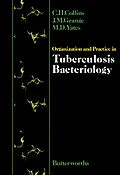Organization and Practice in Tuberculosis Bacteriology focuses on the organization and technical methods of tuberculosis bacteriology.
This book discusses the mycobacteria and mycobacterial disease and role and scope of the tuberculosis laboratory in human and veterinary medicine and epidemiology. The organization of tuberculosis laboratory services; collection, preservation and transport of specimens; and examination of direct smears are also elaborated. This text likewise covers the decontamination of specimens, inoculation of culture media, and identification of species and variants of tubercle bacilli. Other topics include the drug sensitivity tests, animal inoculation and assay tests; problems faced in the therapy of tuberculosis, and lipid chromatography.
This publication is suitable for biologists, medical practitioners, and clinicians concerned with tuberculosis bacteriology.
Inhalt
1 Introduction: Mycobacteria and Mycobacterial Disease
Tuberculosis
Other Mycobacterioses in Man
2 The Role and Scope of the Tuberculosis Laboratory in Human and Veterinary Medicine and Epidemiology
3 The Organization of Tuberculosis Laboratory Services
Grades of Laboratories
Design of the Tuberculosis Laboratory
Equipment
Training and Motivation of Staff
Proficiency Testing
Prevention of Laboratory-Acquired Tuberculosis
4 Collection, Preservation and Transport of Specimens
Sputum
Urines
Aspirated Fluids and Pus
Tissues
Milk Samples
Water Samples
Identifying Specimens
Preservation of Specimens
Transport
5 Examination of Direct Smears
Preparation of Specimens
Staining
Quantitative Microscopy
Precautions against False Positives
Positive Smears - Negative Cultures
Acid- and Alcohol-Fast Bacilli
Storage and Disposal of Slides
6 Cultural Methods
Decontamination of Specimens
Culture Media
Inoculation of Culture Media
Incubation
Examination of Cultures
Radiometrie Method for TB Culture
7 Taxonomic Principles - The Basis of Identification
8 Identification of Species and Variants of Tubercle Bacilli
Nomenclature
Identification
Identification of Variants of M. Tuberculosis and BCG
Variants and Species of Tubercle Bacilli
9 Identification of 'Other Mycobacteria'
Terminology
Identification Methods
Cultural and Biochemical Tests
Lipid Chromatography
Additional Biochemical Tests
Additional Reference Techniques
Species of Medical and Veterinary Interest
Mycobacterium Avium
Mycobacterium Avium-Intracellulare-Scrofulaceum '(MAIS)'
Mycobacterium Chelonei
Mycobacterium Flavescens
Mycobacterium Fortuitum
Mycobacterium Gastri
Mycobacterium Gordonae
Mycobacterium Haemophilum
Mycobacterium Intracellulare
Mycobacterium Kansasii
Mycobacterium Malmoense
Mycobacterium Marinum
Mycobacterium Nonchromogenicum
Mycobacterium Paratuberculosis
Mycobacterium Phlei
Mycobacterium Scrofulaceum
Mycobacterium Simiae
Mycobacterium Smegmatis
Mycobacterium Szulgai
Mycobacterium Terrae
Mycobacterium Triviale
Mycobacterium Ulcerans
Mycobacterium Xenopi
Species of Limited Interest in Human and Veterinary Medicine
10 Drug Sensitivity Tests
The theory of Drug Resistance and Treatment Regimens
Principles of Treatment Regimens
Development of Modern Treatment Regimens
Problems Faced in the Therapy of Tuberculosis
The Treatment of Other Mycobacterial Infections
The Role of Sensitivity Testing
Methods for Sensitivity Tests
11 Animal Inoculation and Assay Tests
Animal Inoculation Tests
Assay of Antimicrobial Agents in Serum and their Detection in Urine
12 Leprosy
Technical Procedures
The Skin
The Nose
Biopsies
Appendix Stains, Culture Media and Other Materials
References
Index
